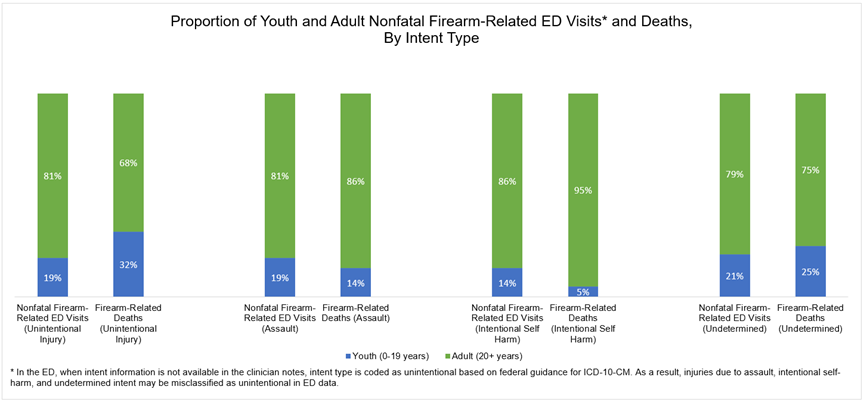In 2020, firearms surpassed motor vehicle crashes to become the leading cause of death among youth under age 20 in the United States (Goldstick et. al, 2022). The rate of youth firearm deaths increased by 29% in 2020 and a further 8.8% in 2021, reaching 5.8 deaths per 100,000 population (Roberts et. al, 2023). Within North Carolina, firearms are the leading cause of violent death among youth (age 0 to 19 years) and adults (age 20+ years), accounting for approximately 65% of violent deaths from January 2019 to December 2020. During this period, there were over 10,000 firearm-related emergency department (ED) visits and one out of every five involved youth. In this blog post, we’ll use data from NC DETECT, North Carolina’s statewide syndromic surveillance system, and the North Carolina Violent Death Reporting System (NC-VDRS) to explore how the intent behind nonfatal firearm-related injury ED visits and firearm deaths among North Carolina youth differ from adults. We’ll also discuss some of the strengths and limitations of intent coding across these two data sources.
Firearm Injury Intent in NC DETECT ED Visit Data
Accurate firearm injury intent coding in ED visit data is challenging. Most ED visits are classified as unintentional for both youth and adults. Injury intent coding is not required for reimbursement and, when intent information is not available in the clinician notes, the federal coding guidance for the use of ICD-10-CM codes states that unintentional intent codes should be used.[1] As a result, assault, self-inflicted injury, and even undetermined firearm injuries may be misclassified as unintentional.
In 2020, 59% of firearm-related ED visits for youth (n=1967) and adults (n=8092) were documented as unintentional intent. Injuries with an undetermined intent, an injury diagnosis with no intent specified,[2] or a non-injury diagnosis code[3] accounted for 23% of youth visits and 21% of adult visits, and assault accounted for the remaining 17% to 18%.
Firearm Injury Intent in NC-VDRS
Firearm-related deaths among youth were most often the result of assault (63%), followed by intentional self-harm (31%). This was the opposite of adult deaths, where 57% were due to self-harm and 39% due to assault. Deaths due to unintentional firearm injury were more common among youth (4%) than adults (1%). Firearm deaths due to legal intervention or with an undetermined intent were rare among youth and adults, accounting for less than 3% of fatalities.
Unlike ED firearm injury data, NC-VDRS data on firearm deaths are assumed to have very accurate intent coding due to the rigor that goes into data abstraction. NC-VDRS is part of a national violent death reporting system whose primary purpose is to provide accurate information on violent deaths.[4] Trained abstractors collect information on circumstances preceding a violent death incident, such as injury characteristics, manner of death, and mechanism(s) leading to the injury, using three sources: death certificates, coroner/medical examiner reports, and law enforcement reports. Optional secondary sources, such as crime lab data, court records, and hospital data, may also be used.[5] Intent for firearm deaths can be identified by examining manner of death and mechanism(s) leading to injury in these various data sources.
Youth and Adult Demographics
In North Carolina, youth make up 24% of the total population and adults make up 76% of the population. Compared to their population, youth are slightly underrepresented in nonfatal firearm ED visits (20%), whereas adults are slightly overrepresented (80%). This skew is more pronounced among firearm deaths—youth make up 9% of deaths and adults make up 91%.

When broken down by intent type, youth make up 19% of nonfatal firearm-related ED visits and 32% of firearm deaths due to unintentional injury, whereas adults make up 81% of nonfatal firearm-related ED visits and 68% of firearm deaths. Unintentional injury is the only intent type in which the proportion of youth deaths is substantially higher than the proportion of North Carolina’s youth population. It is also the only intent type in which youth deaths make up a considerably higher proportion than youth nonfatal ED visits.
For nonfatal firearm-related ED visits and firearm deaths due to assault, youth make up 19% of ED visits and 14% of deaths, whereas adults make up 81% of visits and 86% of deaths.
When looking at intentional self-harm, youth make up 14% of nonfatal firearm-related ED visits and 5% of firearm deaths, whereas adults make up 78% of ED visits and 95% of deaths.
For nonfatal firearm-related ED visits and firearm deaths of undetermined intent, youth make up 21% of ED visits and 25% of deaths, whereas adults make up 79% of ED visits and 75% of deaths.

Comparing the differences in intent behind nonfatal firearm injury and firearm death among youth and adults in North Carolina can provide valuable insights into potentially unique vulnerabilities for firearm injury and death among youth. If you are interested in more information on firearm-related injuries or deaths in North Carolina, you can view the NC-FASTER data reports or visit the NC-VDRS data dashboard.
[1] Centers for Medicare & Medicare Services. ICD-10-CM Official Guidelines for Coding and Reporting. April 1, 2023. Available at: https://www.cms.gov/files/document/fy-2023-icd-10-cm-coding-guidelines-updated-01/11/2023.pdf
[2] “Injury diagnosis, no intent specified” means that the patient has an injury diagnosis code that did not specify firearm injury, but documentation elsewhere in their ED data notes the cause as firearm.
[3] “Non-injury diagnosis code” means that the patient had a diagnosis code that was not for an injury, but a sign or symptom of injury, and documentation elsewhere notes the cause as firearm.
[4] North Carolina Division of Public Health Injury and Violence Prevention Branch. The North Carolina Violent Death Reporting System (NC-VDRS). Available at: https://injuryfreenc.dph.ncdhhs.gov/About/ncVDRS.htm
[5] Centers for Disease Control and Prevention. National Violent Death Reporting System (NVDRS) Coding Manual Revised [Online] 2021 National Center for Injury Prevention and Control, Centers for Disease Control and Prevention (producer). Available at: www.cdc.gov/injury
